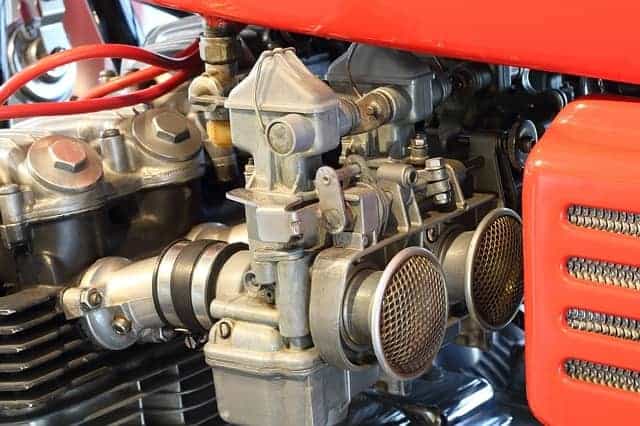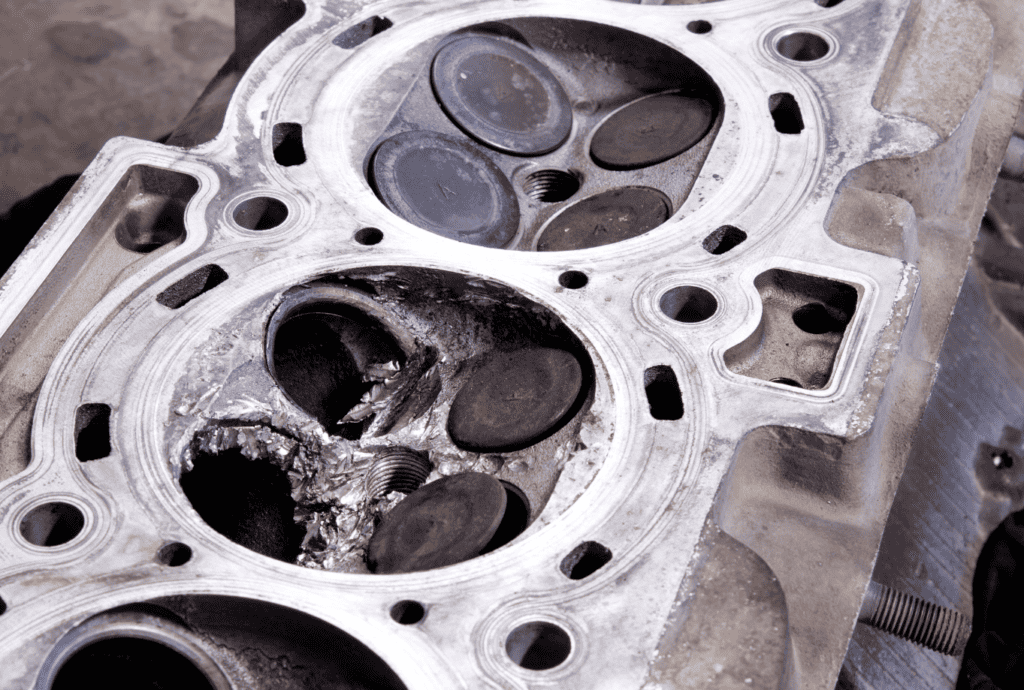
Motorcycle backfiring issues is always a bit alarming, and it can especially be concerning if the backfire is coming from the carburetor. Aside from alarming, it could be a bit puzzling since backfires normally happen through the exhaust. Backfiring in the carburetor can be an indication of an underlying issue that should be addressed quickly.
Why is does a motorcycle backfire through the carburetor? A motorcycle backfires through the carburetor because of a poorly timed spark, intake valve closure issues, or hot carbon build up causing premature detonation. Backfiring through the carb is not a common issue and should be resolved immediately.
In my experience with flipping motorcycles, the carburetor was usually the number one culprit to running issues. Rest assured, I can walk you through the process of why your motorcycle is backfiring through the carburetor and what you can do to fix it.
Why A Motorcycle Backfires Through The Carburetor
The first and most common reason why a motorcycle backfires through the carburetor is because of a poorly timed spark. The only way for a motorcycle to backfire through the carburetor is if there is an open path from your cylinder to the carburetor when the spark plug ignites. If the spark plug is advanced too far (meaning if it sparks too early), your intake valve will still be open and it will cause a backfire through the carburetor.
A poorly timed spark can be caused by bad points (an old system of sparking and isn’t used on newer motorcycles), an incorrectly advanced timing, or on rare occasions, by a faulty ECU (engine control module). In addition, a timing chain could be one tooth off in the advanced direction (it’s one tooth too early on the sprocket). Each of these scenarios could cause the intake valve to be slightly open when the spark plug sparks which will ultimately cause a backfire in the carburetor.
The second most common reason for carb backfiring is mechanical closure issues of the intake valve. Failure to close could be caused by a sticking valve guide, carbon build up on the valve seat, a bent valve, a chipped valve, or improper valve adjustment.
Your intake valve shaft (or the skinny part of your intake valve), rides through a very small cylindrical piece of metal that keeps it straight. The clearance between the valve guide and the valve is very small so if engine gunk or metal shavings or other foreign objects get between the valve and the valve guide, it can cause the valve to open and close more slowly than it should or to not close completely.
Carbon build up can occur on the valve seat due to poor combustion, age, or lack of maintenance over time. If carbon hardens and builds up on the valve seat, it will cause the valve to not close completely. This leaves a path for the fuel to ignite through the carburetor.

If you have a bent valve, you are most likely going to have other mechanical problems within your engine as well. If it’s bent, it means the valve came in contact with another moving piece of the engine, so you most likely will also have cylinder wall damage, valve guide failure, or even a chipped piston.

A chipped valve, even though it may seat properly, creates an open path between the combustion chamber and the carburetor cause a backfire throug the carb. If you have a chipped valve, the backfire, or loud popping, will be very consistent and will never go away. Some of the other backfiring possibilities discussed previously may be intermitent.
Every manufacturer recommends specific clearances for valve adjustment. If your rocker is set too tightly on your intake valve, it may cause your valve to never close completely. Buy a manufacturer specific repair manual for your motorcycle and follow the valve clearance procedure in order to create the correct closure specs (if you’ve lost your repair manual, you can find the correct one for your motorcycle from eManual Online).
You will need a basic set of tools and some feeler gauges. I wouldn’t recommend a beginner mechanic to try this by themselves unless you have someone to help who has done it before.

Lastly, the third most common reason why a motorcycle backfires through the carb is due to hot carbon build up on the valve, upper cylinder wall, or mostly commonly on top of the piston. Every piston in every engine has carbon build up over time, its a natural process of combusting fuel under high pressure and temperature.
But when large amounts of carbon begins to accumulate inside the combustion chamber or on top of the piston, then as soon as air and fuel enter the cylinder, it ignites prematurely because the carbon is so hot. This can be an intermittent condition and will happen more often after you’ve been riding your motorcycle for a while.
Any easy way to check if your motorcycle cylinders have excessive carbon build up is to use a borescope through the sparkplug hole and look for large chunks of black, hard deposits. If you do have large deposits, then it may be time for a top-end engine rebuild.
How Do I Troubleshoot Which Issue Is Causing A Backfire Through The Carburetor?
Now that we’ve discussed the possible reasons a backfire is happening through your motorcycle carb, you may be a little overwhelmed and not know which specific issue is causing your backfiring issue. Let’s discuss what you can do to troubleshoot and pinpoint exactly why that backfire is happening.
Let’s start with how to troubleshoot a poorly timed spark. First, think back to what happened right before the carb backfiring happened: did you recently have any major maintenance performed on your motorcycle? Specifically with the timing? It’s easy to accidentally get your timing off by a few degrees or by 180 degrees if you’re not careful in following the timing procedure. I’ve done this myself on my 1969 triumph. I kept putting the piston in top dead center of the exhaust stroke instead of the compression stroke.
You should be able to remove the side engine cover and asses if the marks on the sprockets and engine block are misaligned. Only do this if you have the manufacturer repair manual and can follow it step by step. You can cause major engine damage if you misalign the timing too much.
If you have an old points and condenser system, it’s easy to improperly adjust the points so they are opening and closing at the wrong time. I also did this on my old Triumph and finally gave up and sought help from a mechanic.
Next, let’s discuss how to troubleshoot if intake valve closure issues is the problem. If you have suspicions that a valve is not closing properly, you can perform a compression test on all cylinders which will determine which cylinder is faulty. Once you know which cylinder is faulty, you can perform a leak-down test to help determine which component on that cylinder may be at fault.
As we had mentioned earlier, when it comes to troubleshooting hot carbon deposits and its impact it has on your carb backfiring, using a borescope is your best bet. There are some really cool borescopes with lights on the end of them that can be plugged in to a cell phone as a viewing device. You can use these by putting them through the spark plug holes.
How To Prevent Backfiring Through Your Motorcycle Carburetor
The type of fuel you use in your motorcycle on a regular basis has a huge impact on carbon build up, fuel combustion, and engine cleanliness. I only use 91 or 93 octane fuel from top tier gas stations (Chevron, Exxon, Costco, Holiday, Marathon, Mobil, Phillips 66, Shell, Sinclair, Valero, and Texaco). Top tier gasoline has fuel additives that clean your motorcycle’s valve train and cylinder right before combustion happens. These additives prevent carbon build up and keep your engine clean.
You can learn more about the correct type of gas for motorcycles by reading our article “What Kind Of Gas Do Motorcycles Use?“
I would also recommend to use a fuel additive and cleaner once a year, such as Sea Foam, to give your engine a thorough cleaning. This will also helps prevent carbon build up. Follow the directions on the Sea Foam container by pouring it in to your gas tank and running the motorcycle. This may cause some temporary smoking, but that is part of the process of the product.
In order to prevent valve timing issues from occuring on your timing chain, make sure to always use a reputable mechanic who has done timing adjustments before (and not your uncle’s best friend who mentioned he’d give you a good deal).
If you have points and a condenser system like on older motorcycles, the points will wear out over time and will need to be slightly adjusted in order to keep the same firing rate.
In order to prevent intake valve closure issues, follow your manufacturer’s repair manual in adjusting your valves. I like adjust my valves every few years to ensure this problem doesn’t happen.
